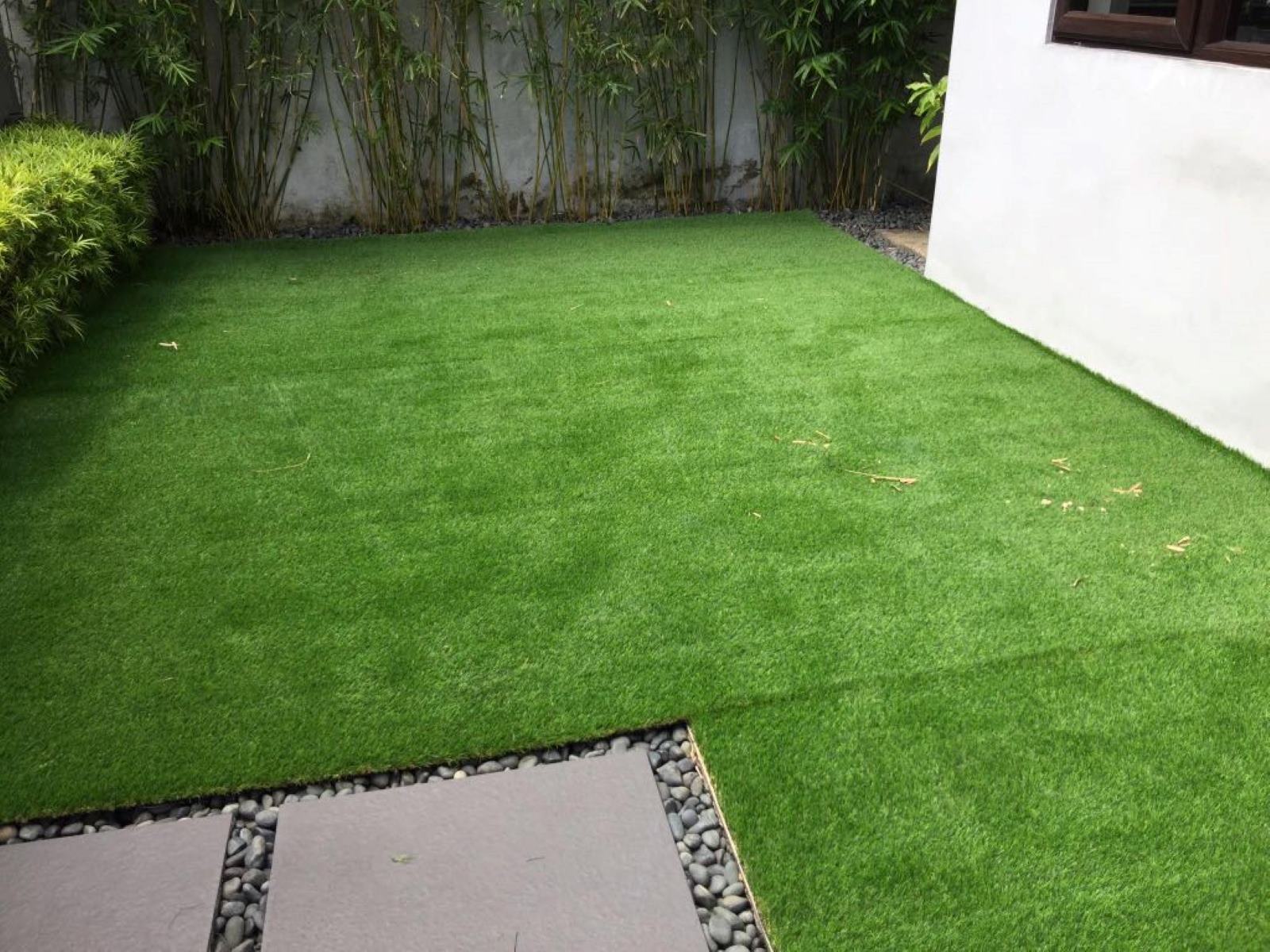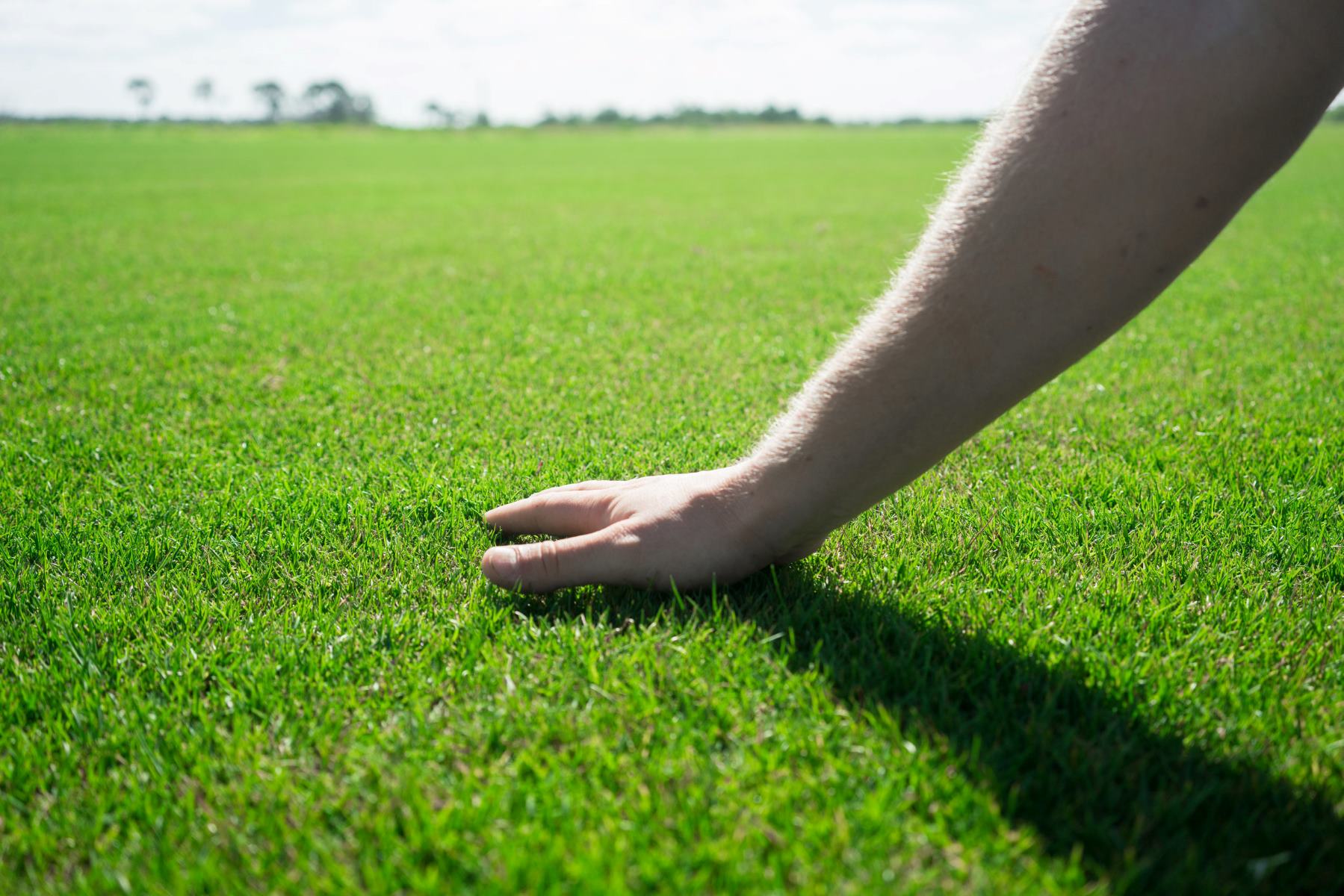Home>Garden Essentials>How To Treat Fungal Disease In Lawn Turf


Garden Essentials
How To Treat Fungal Disease In Lawn Turf
Modified: October 20, 2024
Learn effective methods to treat fungal disease in your garden's lawn turf and maintain a healthy, vibrant outdoor space.
(Many of the links in this article redirect to a specific reviewed product. Your purchase of these products through affiliate links helps to generate commission for Storables.com, at no extra cost. Learn more)
Introduction
Welcome to the world of gardening, where beautiful landscapes and lush green lawns play a pivotal role in transforming outdoor spaces. However, just like any living organism, plants are susceptible to various diseases, and lawn turf is no exception. One common issue that gardeners encounter is fungal diseases in their lawn turf.
Fungal diseases can affect the health and appearance of your lawn, causing unsightly patches, yellowing, or even death of the turf. These diseases are usually caused by different types of fungi, which thrive in moist environments and can spread rapidly if not properly treated.
In this comprehensive guide, we will delve into the world of fungal diseases in lawn turf and present effective strategies to prevent and treat these issues. By understanding the common fungal diseases, implementing proper lawn care practices, and making informed choices regarding treatment methods, you can maintain a healthy and vibrant lawn that will be the envy of your neighbors.
Key Takeaways:
- Understanding the signs of fungal diseases like dollar spot and powdery mildew is crucial for effective treatment. Proper lawn care practices, such as mowing at the right height and improving soil drainage, can prevent fungal infections.
- After treating fungal diseases, maintaining proper watering, mowing, and fertilization practices is essential for long-term lawn health. Organic alternatives like neem oil and compost tea offer natural ways to control fungal infections.
Read more: How To Treat A Astro Turf Burn
Understanding Fungal Diseases in Lawn Turf
Before we dive into the specifics of treating fungal diseases in lawn turf, it’s essential to understand the nature of these diseases and how they can impact your lawn. Fungal diseases are caused by various types of fungi, which can enter your lawn through spores carried by wind, water, or even on the feet of animals.
These fungi thrive in moist and warm conditions, which are often found in poorly drained areas and during periods of high humidity. When the right conditions are present, the fungi can quickly multiply and infect the turf, leading to visible signs of disease.
Common signs of fungal diseases in lawn turf include discolored patches, thinning or dying grass, and the presence of fungal growth such as mushrooms or powdery substances on the turf. It’s important to note that different types of fungi cause different diseases, each with its unique symptoms.
Some of the most common fungal diseases that affect lawn turf include:
- 1. Dollar Spot: This disease appears as small, circular spots on the turf, typically the size of a silver dollar. The affected grass blades develop a tan or straw-colored lesion, giving the disease its name.
- 2. Brown Patch: Brown patch causes irregularly shaped, brown or tan patches to form on the turf. The affected grass blades often have dark brown borders and can easily break off when tugged.
- 3. Powdery Mildew: Powdery mildew presents itself as a white or gray powdery substance on the grass blades. It thrives in dry conditions with high humidity and can cause stunted growth.
- 4. Fairy Ring: Fairy ring appears as a ring of dark green, fast-growing grass surrounded by a ring of dead or dying grass. Fungal mycelium growth beneath the soil causes this disease.
- 5. Red Thread: Red thread manifests as red or pink web-like structures on the turf. It often appears when the lawn is under stress, such as during periods of drought or nutrient deficiencies.
Understanding which specific fungal disease is affecting your lawn is crucial for effective treatment. By recognizing the signs and symptoms, you can take appropriate action to restore your lawn’s health and vitality.
Identifying Common Fungal Diseases in Lawn Turf
Proper identification of fungal diseases in your lawn turf is key to implementing the right treatment strategy. Different diseases require different approaches, so it’s essential to be familiar with their distinct symptoms. Here are some common fungal diseases and how to identify them:
- Dollar Spot: Dollar spot appears as small, straw-colored or tan spots that are approximately the size of a silver dollar. These spots can merge together and form larger patches. The affected grass blades have lesions that look like hourglass shapes.
- Brown Patch: Brown patch causes circular or irregularly shaped tan or brown patches on the lawn. These patches can range from just a few inches to several feet in diameter. The grass blades within the affected areas often have a dark brown border that distinguishes them from the healthy turf.
- Powdery Mildew: Powdery mildew presents itself as a white or gray powdery substance on the grass blades, resembling talcum powder. It often occurs in shaded areas with poor air circulation. The affected grass may appear stunted or have distorted growth patterns.
- Fairy Ring: Fairy ring is characterized by a visible ring of dark green, fast-growing grass accompanied by a ring of dead or dying grass. Fungal mycelium growth underground causes this distinct pattern. Mushroom growth may also be present within the ring.
- Red Thread: Red thread manifests as pink or red web-like structures on the grass blades. It usually occurs when the lawn is under stress, such as during periods of extended wetness or nutrient deficiencies. The affected grass may have thin or irregularly shaped patches.
When identifying fungal diseases, it’s essential to closely examine the affected areas and compare them to pictures or descriptions of common lawn diseases. You can also seek assistance from local gardening experts or consult with your local agricultural extension office for accurate diagnosis.
Moreover, keep in mind that other factors, such as improper watering, nutrient deficiencies, or insect damage, can mimic the symptoms of fungal diseases. Therefore, it’s crucial to rule out other potential causes before settling on a treatment plan.
Once you have properly identified the fungal disease affecting your lawn turf, you can proceed with implementing the appropriate treatment and prevention methods to restore the health and beauty of your lawn.
Proper Lawn Care Practices to Prevent Fungal Diseases
Prevention is always better than cure when it comes to fungal diseases in lawn turf. By adopting proper lawn care practices, you can create a healthy and resilient turf that is less susceptible to fungal infections. Here are some essential practices to prevent fungal diseases:
- Mowing at the right height: Proper mowing height is crucial for maintaining a healthy lawn. Each grass species has an ideal mowing height, and cutting the grass too short can weaken it and make it more susceptible to fungal diseases. Regularly mow the grass to the recommended height for your specific grass type.
- Watering correctly: Proper watering is critical to prevent fungal diseases. Avoid overwatering, as excessive moisture can create a favorable environment for fungal growth. Deep, infrequent watering is generally recommended, as it encourages the development of deep root systems and reduces surface moisture.
- Improving drainage: Poor drainage can lead to excessive moisture buildup, increasing the likelihood of fungal diseases. Ensure your lawn has proper drainage by addressing any areas that collect standing water. You can improve drainage by aerating the soil or installing drainage systems if needed.
- Avoiding over-fertilization: While fertilizers are essential for lawn health, over-fertilization can promote excessive growth and weaken the turf, making it more susceptible to diseases. Follow recommended fertilization schedules and use the appropriate nutrients based on soil testing.
- Aerating the soil: Regularly aerating the soil helps improve air circulation and water penetration, reducing the chances of fungal diseases. Aerating loosens compacted soil, allowing roots to access nutrients and water more effectively.
- Promoting good air circulation: Proper air circulation is crucial for preventing fungal diseases. Trim trees and shrubs to allow adequate sunlight penetration and airflow throughout your lawn. Avoid overcrowding plants in one area, as it can create shady and humid conditions that favor fungal growth.
- Removing thatch: Thatch is a layer of dead organic matter that accumulates between the grass blades and the soil surface. Excessive thatch can trap moisture and create a breeding ground for fungal diseases. Regularly dethatch your lawn to maintain a healthy turf.
- Properly storing lawn equipment: Fungal spores can survive on lawn equipment, such as mowers and trimmers, and spread to healthy areas. Clean and disinfect your equipment after use, especially when working in an area affected by fungal diseases.
By implementing these proper lawn care practices, you can create an environment that discourages fungal diseases and promotes the overall health and vitality of your lawn turf. Prevention is key, and a little extra effort in maintaining a healthy lawn can go a long way in keeping fungal diseases at bay.
Testing and Soil Preparation for Treating Fungal Diseases
Before implementing any treatment for fungal diseases in lawn turf, it’s important to assess the health of your soil and make necessary adjustments. Testing your soil can provide valuable insights into its nutrient levels, pH balance, and overall composition, helping you determine the best course of action. Here are the steps to testing and preparing your soil for treating fungal diseases:
1. Soil Testing:
Start by collecting soil samples from different areas of your lawn. Use a soil probe or a trowel to collect samples about 4-6 inches deep. Combine the soil samples in a clean container and mix them thoroughly. Take a representative sample from this mixture and send it to a reputable soil testing laboratory for analysis.
The soil test results will provide information on the pH level, nutrient deficiencies, and excesses in your soil. This information will help you determine the appropriate amendments and treatments needed to promote a healthy lawn and combat fungal diseases.
2. Adjusting pH Levels:
The pH level of your soil plays a crucial role in nutrient availability and overall lawn health. Most lawn grasses prefer a slightly acidic pH level between 6.0 and 7.0. If your soil test indicates a pH imbalance, you can adjust it by adding lime to raise the pH or sulfur to lower it. Follow the recommended application rates based on your soil test results.
3. Improving Soil Drainage:
Poor drainage can contribute to the development and spread of fungal diseases. If your soil test reveals drainage issues, you can take steps to improve it. For compacted soil, consider aerating to loosen it and improve water infiltration. Adding organic matter, such as compost or well-rotted manure, can also enhance soil structure and drainage abilities.
4. Selecting Disease-Resistant Grass Varieties:
When reseeding or establishing a new lawn, consider using grass varieties that are known to be resistant to fungal diseases prevalent in your area. Disease-resistant grass varieties are less likely to succumb to infections and can help prevent the onset of fungal diseases.
5. Pruning and Thinning:
Proper pruning and thinning of trees and shrubs around your lawn can improve air circulation and reduce shading, creating an environment less suitable for fungal growth. Remove any dead or diseased branches and ensure sufficient space between plants to promote airflow.
6. Following Proper Watering Practices:
Watering is essential, but how you water your lawn can impact its susceptibility to fungal diseases. Water deeply and infrequently, allowing the soil to dry out between waterings. This practice encourages the development of deep root systems and minimizes surface moisture that can contribute to fungal growth.
By testing and preparing your soil, you can address any underlying issues and create an environment that supports a healthy lawn turf. Soil preparation plays a crucial role in preventing and treating fungal diseases, enabling you to achieve long-term success in maintaining a vibrant and disease-free lawn.
To treat fungal disease in lawn turf, improve air circulation by pruning surrounding plants and avoid overwatering. Apply a fungicide specifically designed for lawn turf according to the manufacturer’s instructions.
Read more: How To Treat Thatch In Lawns
Choosing and Applying Fungicides for Lawn Turf
When fungal diseases in your lawn turf become persistent and preventative measures alone are not enough, it may be necessary to use fungicides to control and treat the infections. Fungicides are chemical or biological substances that target specific fungi and prevent their growth or eradicate existing infections. Here are some key considerations for choosing and applying fungicides for lawn turf:
1. Identify the specific fungal disease:
Proper identification of the fungal disease affecting your lawn is crucial before selecting a suitable fungicide. Different types of fungi require specific fungicides for effective control. Consult with local gardening experts or your agricultural extension office to accurately identify the disease and determine the appropriate treatment.
2. Choose the right fungicide:
There are different types of fungicides available, including contact and systemic fungicides. Contact fungicides remain on the surface of the plants and work by directly killing the fungus upon contact. Systemic fungicides, on the other hand, are absorbed by the plant and provide protection from within. Consider the mode of action, effectiveness against the specific fungus, and any potential environmental concerns when selecting a fungicide.
3. Read and follow the label instructions:
Before purchasing and using any fungicide, carefully read and follow the label instructions provided by the manufacturer. The label will provide specific information on the application rate, timing, safety precautions, and any restrictions or waiting periods before reentering the treated area.
4. Timing of application:
The timing of fungicide application is crucial for effective control. Apply the fungicide as soon as you observe the first signs of the disease or as recommended for the specific fungal infection. Early intervention can prevent further spread and damage to the lawn turf.
5. Proper application technique:
Follow the recommended application technique to ensure even coverage and maximize the effectiveness of the fungicide. Use a sprayer specifically designed for lawn applications, and apply the fungicide during calm weather conditions to minimize drift. Take care to avoid applying the fungicide to non-target plants or areas.
6. Post-application care:
After applying the fungicide, monitor the treated area closely and follow any specified post-application care instructions. This may include avoiding mowing or irrigating for a certain period, depending on the fungicide used. Proper post-application care will help optimize the fungicide’s effectiveness and promote the recovery of the lawn turf.
7. Consider environmental impact:
When choosing and applying fungicides, consider their impact on the environment. Opt for fungicides with lower environmental toxicity and follow all appropriate safety measures to minimize any potential harm to beneficial insects, wildlife, or water sources.
It’s important to note that fungicides should be used as a last resort when preventive measures have failed to control the fungal diseases in your lawn turf. Always follow the instructions and guidelines provided by the manufacturer to ensure safe and effective use.
Organic Alternatives for Treating Fungal Diseases
If you prefer a more natural approach to treating fungal diseases in your lawn turf, there are several organic alternatives available that can be effective in controlling and preventing these infections. Organic methods focus on enhancing the overall health of the lawn and creating an environment that is less favorable for fungal growth. Here are some organic alternatives to consider:
1. Cultural Practices:
Implementing proper cultural practices can significantly reduce the susceptibility of your lawn turf to fungal diseases. This includes mowing at the correct height, watering deeply and infrequently, improving soil drainage, and promoting good air circulation through pruning and thinning of plants. By creating optimal growing conditions for your lawn, you can strengthen its natural defenses against fungal infections.
2. Neem Oil:
Neem oil is a natural product derived from the neem tree and has antifungal properties. It works by disrupting the growth and reproduction of fungal pathogens. Dilute neem oil according to the manufacturer’s instructions and spray it over the affected areas of your lawn. Repeat the application as necessary to control the fungal disease.
3. Baking Soda:
Baking soda has long been used as a natural remedy for fungal infections. Mix 1 tablespoon of baking soda with 1 gallon of water and spray it on the affected areas of your lawn. Baking soda creates an alkaline environment that inhibits the growth of fungi. However, avoid using baking soda solutions on plants that prefer acidic soil, as it can disrupt their pH balance.
4. Compost Tea:
Compost tea is a nutrient-rich liquid fertilizer that also contains beneficial microorganisms. It helps improve soil health and enhances the natural disease resistance of plants, including grass. Apply compost tea to your lawn using a sprayer or watering can. The beneficial microorganisms in the compost tea can help suppress fungal pathogens and promote the growth of beneficial microbes in the soil.
5. Biofungicides:
Biofungicides are organic fungicides derived from living organisms, such as bacteria or fungi, that can control fungal diseases. Examples include bacillus subtilis and Trichoderma spp. These organisms compete with pathogenic fungi for resources and produce substances that inhibit their growth. Biofungicides are typically safe to use around humans, animals, and beneficial insects, and they have low environmental impacts.
6. Good Cultural Sanitation:
Promote good cultural sanitation practices to prevent the spread and recurrence of fungal diseases. This includes removing and disposing of infected plant debris, avoiding overwatering, and cleaning and sanitizing garden tools and equipment after use. Proper sanitation can help eliminate potential sources of fungal spores and reduce the risk of reinfection.
While organic alternatives may take longer to show results and may require more frequent applications compared to synthetic fungicides, they offer a natural and environmentally friendly approach to treating and preventing fungal diseases in your lawn turf. By incorporating these organic methods into your lawn care routine, you can promote the long-term health and vitality of your lawn while minimizing the use of chemical treatments.
Post-Treatment Maintenance and Prevention Strategies
After treating fungal diseases in your lawn turf, it’s essential to implement post-treatment maintenance and prevention strategies to ensure the long-term health and vitality of your lawn. These strategies will help minimize the risk of future fungal infections and keep your lawn looking its best. Here are some post-treatment maintenance and prevention strategies to consider:
1. Follow Proper Watering Practices:
Proper watering is crucial to prevent the reoccurrence of fungal diseases. Water deeply and infrequently, allowing the soil to dry out between waterings. Avoid overhead irrigation, as it increases the chances of fungal spore spread. Water in the early morning hours to allow the grass blades to dry quickly.
2. Maintain Optimal Mowing Height:
Continue to mow your lawn at the recommended height for your specific grass species. Cutting the grass too short weakens it and makes it more susceptible to fungal infections. Regular mowing at the right height promotes a strong and healthy turf.
3. Implement Proper Fertilization:
Proper fertilization is crucial for maintaining a healthy lawn and boosting its natural defenses against fungal diseases. Follow the recommended fertilization schedule for your grass type, and use a balanced fertilizer that provides the necessary nutrients in the right proportions.
4. Monitor and Control Weeds:
Weeds can compete with grass for water, nutrients, and sunlight, weakening the turf and making it more susceptible to fungal diseases. Stay vigilant and promptly address any weed issues by pulling or applying appropriate herbicides. Maintaining a weed-free lawn improves overall turf health and resilience.
5. Improve Soil Health:
Continue improving the health of your soil by regularly adding organic matter, such as compost, to provide essential nutrients and enhance soil structure. Healthy soils support strong root development, which helps fend off fungal infections.
6. Promote Good Air Circulation:
Continue pruning and thinning trees and shrubs to ensure proper air circulation throughout your lawn. Good air movement helps to dry out the grass blades quickly and reduces the likelihood of fungal disease development.
7. Regularly Monitor Your Lawn:
Regularly inspect your lawn for any signs of fungal diseases or other issues. By catching potential problems early, you can take immediate action and prevent the spread and severity of infections. Promptly address any areas of concern through appropriate treatment or cultural practices.
8. Promote Overall Lawn Health:
A healthy lawn is less likely to succumb to fungal infections. Ensure your lawn receives the necessary nutrients, sunlight, and water it needs to thrive. Implement proper lawn care practices and address any issues promptly to maintain the overall health and vigor of your turf.
By following these post-treatment maintenance and prevention strategies, you can create an environment that discourages fungal diseases and promotes the long-term health and resilience of your lawn. Regular care and attention will help keep your lawn looking beautiful and thriving for seasons to come.
Conclusion
Fungal diseases can pose a significant threat to the health and appearance of your lawn turf. However, by understanding these diseases, implementing proper lawn care practices, and taking proactive measures, you can prevent and treat fungal infections effectively.
It all starts with knowledge. Recognizing the signs and symptoms of common fungal diseases such as dollar spot, brown patch, powdery mildew, fairy ring, and red thread is essential for successful control. Proper identification allows you to choose the appropriate treatment methods and implement them in a timely manner.
Prevention plays a crucial role in maintaining a disease-free lawn. By practicing good cultural habits, such as mowing at the right height, watering correctly, improving soil drainage, and promoting good air circulation, you can create an environment that is less favorable for fungal growth.
In cases where prevention alone is not enough, fungicides can be used as a last resort. Understanding the specific fungal disease and choosing the right fungicide is vital for effective control. Follow the label instructions and apply the fungicides correctly to ensure their maximum effectiveness.
For those seeking organic alternatives, options like neem oil, baking soda, compost tea, and biofungicides provide natural and environmentally friendly treatments. These methods focus on enhancing the overall health of the lawn and creating conditions that are less conducive to fungal diseases.
Post-treatment maintenance and prevention strategies are essential for long-term success. By following proper watering practices, maintaining optimal mowing height, implementing proper fertilization, promoting good air circulation, and monitoring the lawn regularly, you can minimize the risk of future fungal infections and keep your lawn in top shape.
In conclusion, tackling fungal diseases in lawn turf requires a multi-faceted approach that includes prevention, identification, treatment, and ongoing maintenance. By combining proper lawn care practices, organic alternatives, and timely intervention, you can achieve a healthy, vibrant, and disease-free lawn that will be the envy of your neighbors. Happy gardening!
Frequently Asked Questions about How To Treat Fungal Disease In Lawn Turf
Was this page helpful?
At Storables.com, we guarantee accurate and reliable information. Our content, validated by Expert Board Contributors, is crafted following stringent Editorial Policies. We're committed to providing you with well-researched, expert-backed insights for all your informational needs.















0 thoughts on “How To Treat Fungal Disease In Lawn Turf”